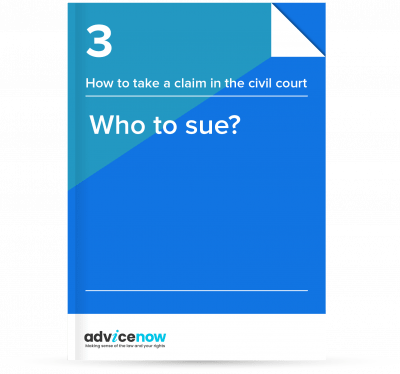Legal language - We try to explain any legal language as we go along, but there is also a ‘What does it mean?’ section at the end.

Introduction
Top tip
See "Should I sue?" for vital information on taking a case to court and how to assess what amount you might win and if it will be worth the hassle. Also read An overview of the process of taking a claim in the civil court to get an understanding of what a typical case might look like.
What is a defendant?
‘Defendant’ is what the law calls the person, company or organisation whom you have taken court action against. Sometimes there may be more than one defendant because, for example, you think that more than just one person, company or organisation shares responsibility for what happened to you.
The purpose of taking someone to court like this is to get the court to make a decision in your favour (a judgement) and award you compensation. You might use the small claims court, or the fast-track process in a county court. This guide is part of our series about taking someone to the civil court to sort out a problem or disagreement.
This guide will help you find the right defendant and get all their details correctly if you:
- are taking someone to court in either England or Wales, and
- your case involves a claim for £25,000 or less, and
- you are representing yourself (you are a litigant in person) and not eligible to have your case paid for by legal aid, a trade union, or insurance.
It will not help you if your case is:
- a criminal case,
- a family case (such as an application for a domestic violence injunction or a divorce - see Help to deal with family problems),
- a housing disrepair or housing possession case including mortgage possession - see Help to deal with housing problems,
- about an injunction (including court claims about anti-social behaviour)
- a medical accident case,
- a case involving defamation (that is libel or slander) or
- a tribunal case (such as a discrimination, employment or immigration case).
This guide is also for people supporting litigants in person, for example Support Through Court volunteers, Citizens Advice volunteers, advice workers and court staff, as well as relatives and friends.
Please take a look at the whole series that explains how can I sue someone.
Updated January 2024
It's not always obvious who to sue
What is suing someone?
If you sue someone, you start a process to take someone to court. This can also be known as taking legal action, bringing a civil claim, going to court, starting legal proceedings or litigation.
The purpose of suing is to get the court to make a decision in your favour (called ‘a judgment’) and decide how the unfairness should be put right (called a 'remedy'). The remedy is usually an amount of money as compensation.
Jane's story
... When I complained to my boss about tripping over the cleaner's cable he not only said it was all my own fault, but also that it was nothing to do with him. He said he rented the office space, and the cleaner was supplied by the landlord through an external cleaning company, and I should take it up with them. I started by writing to my boss's company, and they referred it to their insurers, who also told me it was the cleaning company's problem. I thought about it carefully, and to be on the safe side I sued my employer and the cleaning company, and then their insurers sorted it out between them, paying me half each. I'm very glad I didn't leave it all till the last minute to find it wasn't as simple as I thought.
Once you have decided to start the process to take someone to court you need to be able to identify who may be responsible for your problem. Sometimes this is obvious but in other cases it can be hard to identify who made the mistake, made the decision, or gave you the service that caused your problem.
It is also possible for someone to be responsible for what happened to you even though they did not personally cause the problem. For example, employers are usually held responsible for the actions of their employees, and where this is the case it is generally much better to take the employer to court rather than the individual employee, as the employer is more likely to have insurance and have enough money to pay you compensation if you win.
Starting court proceedings against the wrong person, company or organisation is a waste of time and money. And the court can order you to pay the legal costs of any defendant you have wrongly involved in legal proceedings. So, it is important to know the identity and accurate name of the defendant or defendants.
How to identify the right defendant
 If you are having trouble identifying the right defendant or defendants there are a number of things you can do to try to work it out. A practical and sensible approach is to write to everyone who might be legally responsible, saying what the problem is and why you think they are responsible, and that you will take them to court as a defendant. This is not a foolish step as the Court requires that all sides, or potential sides, to a court case should co-operate to ensure the smooth and economical running of the case.
If you are having trouble identifying the right defendant or defendants there are a number of things you can do to try to work it out. A practical and sensible approach is to write to everyone who might be legally responsible, saying what the problem is and why you think they are responsible, and that you will take them to court as a defendant. This is not a foolish step as the Court requires that all sides, or potential sides, to a court case should co-operate to ensure the smooth and economical running of the case. There are other steps you can and should think about, depending on what your dispute is about.
If you have been dealing with an insurer, the correct defendant is still the individual or organisation that caused your problem. Do not be misled into suing the insurer! But there are special rules about dealing directly with the insurer in some personal injury and road traffic cases. Please do read our separate guide How to make a small claim about injuries caused by a car accident which talks you through the new online system for the pre-action protocol (things you have to do before taking court action) and how to go to court about it afterwards if you need to.
If you want to take a claim against your employer, you will need to find your letter of appointment or contract of employment to make sure you have got the right organisation. Looking at your wage slip may not be enough, as some people are paid by an organisation which is not actually their employer. For example, if you work in a voluntary (religious) school, the local authority pays the wage bill, but the correct defendant will probably be the governing body of the school.
Some organisations outsource work, and their workers wear a uniform of that company, or drive a vehicle with the company logo, but are not treated as employees, and so the organisation may say they are not responsible for the problem and refer you to the outsourced contractor or subcontractor.
If you are a tenant, you might find you have lots of dealings with a managing agent rather than your landlord. It is natural to feel the managing agents should be the defendant, but the correct defendant is almost certainly the landlord – however you will need to check your tenancy agreement.
If you are taking a business to court, you need to check if you are suing a sole trader, company or a partnership. There are two types of partnership - a traditional partnership and a limited liability partnership (LLP). There are specific rules around naming partnerships and LLPs on a claim form, so it is important that a claimant knows what sort of partnership they are suing and which rules apply.
A traditional partnership is a buiness where individuals, possibly trading under a trading name, carry full legal and financial responsibility for their actions - in this case you will need to ensure that you get the name of any individuals exactly right, together with any trading names. If you are unsure of all the names, you can ask the firm to provide a partnership membership statement. In most cases against a traditional partnership, you will make your claim against the business name of the partnership. See Practice Direction 7A.7.3 and Practice Direction 16.2.4.
On the other hand, you might be suing a private limited company (Ltd) or a public limited company (Plc) in which case you will generally sue the company itself and not the individuals behind the company. The exception to this would be if, for example, a director gave you a personal guarantee – in that case it might be appropriate to claim against an individual.
How to find the right address for the defendant
Once you are sure you have identified the right defendant you will need to find the correct address for them to allow any court documentation to be served upon them correctly. In the case of a limited company, either public or private, this will be their registered address which can found at Companies House.
Unless you are soon to be out of time for issuing your claim (see Time limits for suing someone guide which forms part of this series) you should not issue proceedings unless and until you have the defendant’s correct address (which is referred to as the address for service).
If you have been dealing with an insurer directly about something their insured person has done, you will still need to use the insured person’s address on the form, not the insurer's address. An insurer with whom you have been communicating might request that proceedings be served upon them or their solicitors directly, in which case you would use the address that they have provided you with - however it is important that they send you such a request in writing to evidence that you have the correct address for service. Dealing with an insurer or their solicitors directly can be useful, as they may be more efficient and reliable than the defendant.
If you are finding it difficult to trace your defendant you could try searching central or local records.
For example, you can:
- ask for information about the registered keeper of a vehicle.
- find current and past residents at an address in the Electoral Register either at your local town hall or library or on the www.192.com.
You will need to allow plenty of time for this, as data protection laws mean that many keepers of data require a reason (possibly in writing) to allow you access – explain it is for the purpose of litigation.
There are also people who provide tracing services called 'enquiry agents.' You may want to consider this option but check the cost before you go ahead. Some enquiry agents will agree not to charge if they are unable to trace the defendant. This is sometimes referred to as ‘no trace, no fee’. You can find an enquiry agent through the Association of British Investigators or the Institute of Professional Investigators.
If you are not sure who is legally responsible for what happened in your case, you may be able to get legal advice. See our guidance on how to get free legal advice about a small claim.
Describing the defendant correctly
Once you know who you need to name on the court form/money claim, and where they can be found, you need to think about how you will describe them for the purposes of issuing court proceedings. Whilst this might seem like a simple task it can sometimes be tricky if the defendant is a sole trader. It is essential that you get it right to ensure that your time and money is not wasted unnecessarily.
Listed below are some examples of how you might describe a defendant for the purpose of court proceedings, depending on whether they’re a person or a company.
Type of legal entity | Example description for the purpose of service |
Individual | Mr Joe Blogs 1 John Street Manchester M1 1JS |
Sole Trader | Mr Joe Blogs T/A Joe Blogs Shoes 1 John Street Manchester M1 1JS |
Traditional Partnership | Together Forever Weddings (a Firm) 1 John Street Manchester M1 1JS |
Limited Liability Partnership (LLP) | Together Forever Weddings LLP 1 John Street Manchester M1 1JS |
Private Limited Company (Ltd) | Together Forever Ltd 1 John Street Manchester M1 1JS |
Public Limited Company (Plc) | Together Forever Plc 1 John Street Manchester M1 1JS |
If you’re unsure as to whether or not the defendant is a sole trader, partnership, Limited Liability Partnership (LLP), Private Limited Company (Ltd), or Public Limited Company (Plc) you could check their website, headed notepaper, or search for them on Companies House.
About this guide
Disclaimer
The information in this guide applies to England and Wales only. The law may be different if you live in Scotland or Northern Ireland. The law is complicated. We have simplified things in this guide. Please don’t rely on this guide as a complete statement of the law. We recommend you try and get advice from the sources we have suggested.
The cases we refer to are not always real but show a typical situation. We have included them to help you think about how to deal with your own situation.
Acknowledgements
This guide was produced by Law for Life's Advicenow project. We would like to thank everybody who commented on the guide, including editorial teams at Thomson Reuters who kindly peer reviewed it this updated version.

January 2024
Next steps
Now that you know who the right defendant or defendants are, and the correct address for issuing proceedings, you need to look at other guides in this series, particularly Find out if the defendant is worth suing and Time limits for suing someone.
You can see all the guides in this series on our Going to a civil court page
What does it mean?
Address for service - the defendant's correct address for the purpose of court proceedings. If it is an individual, it is likely to be their home address. If it is a company it will be their registered address, which could be somewhere entirely different from where your problem occurred.
Assets - money and savings and other valuable items which can be used to pay debts, for example, a house, flat, jewellery or car.
Civil court – a court, usually a county court, where you can bring a claim for damages (financial compensation) against someone who has wrongly caused you loss, damage or injury. You might use the small claims court, or the fast-track or multi-track process in a county court.
Defendant - person or organisation the case is brought against.
Enquiry agent - a person or business who can be hired to find someone or to find things out about someone, for example, if they have assets.
Issue of proceedings – the formal start to the court proceedings.
Litigant in person – a person bringing or defending a claim without a solicitor or barrister.
Litigation – the process of bringing a claim or taking legal action.
Party – a person or group of people forming one side in a dispute.
Parties – both sides in the dispute.
Pre-action protocol - the things you have to do before taking court action. The are different pre-action protocols for different types of case. See Things you need to know about court procedure before you sue someone for detail about pre-action protocols.
Suing - If you sue someone you take thenm to court over a civil matter. This can also be known as taking legal action, bringing a civil claim, going to court, starting legal proceedings or litigation. The purpose of suing someone is to get the court to make a decision in your favour (called ‘a judgment’) and award a remedy, usually money compensation.
Vicarious liability – when someone is responsible for what happened to you even though they did not personally cause the problem. For example, employers are usually held responsible for the actions of their employees.